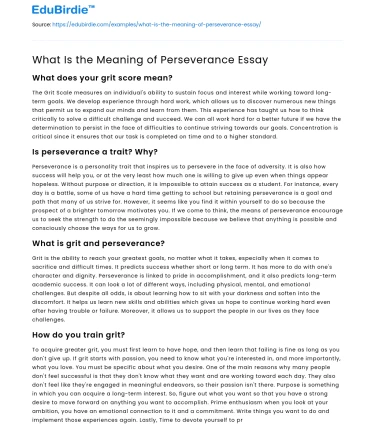Introduction
Perseverance is a fundamental attribute that has been celebrated in various cultural, historical, and educational contexts. It is often described as the steadfastness in doing something despite difficulty or delay in achieving success. This tenacity is considered a crucial element of personal and professional growth, serving as a determinant in overcoming obstacles and achieving long-term goals. In contemporary society, characterized by rapid technological advancements and an ever-evolving socio-economic landscape, understanding the meaning and implications of perseverance is more pertinent than ever. This essay aims to explore the multifaceted nature of perseverance, examining its significance through analytical lenses and real-world examples. By delving into both the psychological underpinnings and societal implications of perseverance, this discourse seeks to elucidate its role as a catalyst for success and resilience.
The Psychological Framework of Perseverance
Perseverance is deeply rooted in psychological constructs, intertwining with concepts such as grit, motivation, and resilience. Psychologist Angela Duckworth defines grit as "passion and perseverance for long-term goals," emphasizing the importance of sustained effort and interest over time (Duckworth, 2016). This intrinsic quality is distinguished from mere talent or intelligence; rather, it is the persistent drive that propels individuals to continue striving despite setbacks. For instance, Thomas Edison’s journey in inventing the light bulb epitomizes perseverance. He famously stated, "I have not failed. I've just found 10,000 ways that won't work." This perspective highlights perseverance as a mindset grounded in resilience and an unwavering commitment to a vision.
Save your time!
We can take care of your essay
- Proper editing and formatting
- Free revision, title page, and bibliography
- Flexible prices and money-back guarantee
Moreover, perseverance is closely linked to self-regulation and delayed gratification. The ability to forego immediate rewards in pursuit of larger, albeit distant, objectives is a hallmark of perseverance. The Stanford Marshmallow Experiment, conducted by Walter Mischel, illustrates this concept vividly. Children who demonstrated self-control and waited for a more significant reward—two marshmallows instead of one—were found to have better life outcomes. This experiment underscores how perseverance, through self-discipline, can be a predictor of success. However, it is essential to consider that perseverance may not always lead to favorable outcomes. Critics argue that relentless persistence in the face of insurmountable challenges could lead to burnout or wasted effort if not strategically managed.
Societal Implications and Real-World Applications
The societal implications of perseverance extend beyond individual success, influencing collective progress and innovation. In the realm of education, perseverance is often cultivated through curricula that emphasize problem-solving and critical thinking. Educational theorist Carol Dweck's research on growth mindset illustrates how fostering a belief in the ability to improve through effort can enhance perseverance among students. This mindset encourages learners to view challenges as opportunities for growth rather than insurmountable obstacles, thereby promoting a culture of resilience and adaptability.
In the professional sphere, perseverance is a valued trait that can differentiate between transient success and sustainable achievement. Entrepreneurs, in particular, are frequently lauded for their perseverance in navigating the uncertainties and failures inherent in starting and managing businesses. A notable example is Steve Jobs, whose perseverance after being ousted from Apple led to his eventual return and the company's subsequent resurgence. His story is a testament to how perseverance can drive innovation and long-term success, even in the face of significant setbacks.
However, it is crucial to balance perseverance with strategic flexibility. As Jim Collins posits in his book "Good to Great," successful organizations are those that can adapt and pivot in response to changing circumstances while maintaining a steadfast commitment to their core values. This perspective suggests that while perseverance is essential, it should not be conflated with stubbornness or rigidity. Instead, it should be complemented by an openness to change and a willingness to adjust one's approach when necessary.
Conclusion
In conclusion, perseverance is a multifaceted construct that encompasses psychological resilience, strategic persistence, and societal impact. It is a vital component of personal and professional development, enabling individuals and organizations to navigate challenges and achieve long-term goals. While perseverance is often celebrated as a virtue, it is essential to recognize the potential pitfalls of unyielding persistence without strategic direction. By understanding the nuanced nature of perseverance, individuals can harness its power effectively, balancing determination with adaptability. As society continues to evolve, the ability to persevere amidst uncertainty will remain an invaluable asset, driving innovation and progress across all domains.
The exploration of perseverance reveals its complexity and significance in shaping human experiences and achievements. As we strive to cultivate perseverance within ourselves and our communities, it is imperative to foster environments that support resilience, adaptability, and strategic thinking. By doing so, we can unlock the true potential of perseverance, propelling us toward a future marked by growth and success.






 Stuck on your essay?
Stuck on your essay?

